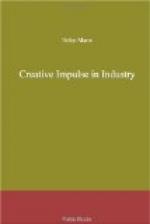The present is better than any time earlier in the history of technology for the development of a concept of industry as a socially creative enterprise. As craftsmanship extended and intensified an interest in personal ownership, it magnified the value of possessions; as it deepened the desire for protection of private property and the strengthening of property laws against human laws, it was not a socializing force. While the craftsmanship period strengthened personal claims on workmanship and interest in it, mechanical power and division of labor have impersonated industry.[A] In the labyrinth of mechanical processes and economic calculation it is not to-day possible for a worker to think or speak of a product as his. He has no basis for ownership claims in any article; even the price is arranged between buyer and seller and he is not the seller. An article owes its existence to an infinite number of persons and its place in the market to as many more.
[Footnote A: Thorstein Veblen—Instinct of Workmanship, Chapter V.]
A worker’s claim to the product of his labor is merged in an infinity of claims which makes the product more nearly the property of society than of any one individual. And this merging of claims which has resulted in the submerging of all wage workers, has set up the new educational task of discovering the possibilities for creative experience in associated enterprise.
While an article manufactured under business conditions is the product of enforced association, we have in this condition the mechanics of a real association. As it now stands, the association is one of individuals, with the impulse for association and for creative effort left out. The interests of some ninety workers associated together in the making of a shoe are not common but antagonistic, except as they are common in their antagonism to the owner of the shoe on which they work. They hang together because they must; their parting is the best part of a working day.
And yet the practice of dividing up the fabrication of an article among the members of a group instead of confining the making of it to one or two people, opens up the possibility of extensive social intercourse, and has the power, we may discover, to sublimate the inordinate desire for the intensive satisfaction of personal life. Although the division of labor has given us a society which is abortive in its functioning like a machine with half assembled parts, it offers us the mechanics for interdependence and the opportunity to work out a cooerdinated industrial life.
CHAPTER II
ADAPTING PEOPLE TO INDUSTRY—THE AMERICAN WAY




